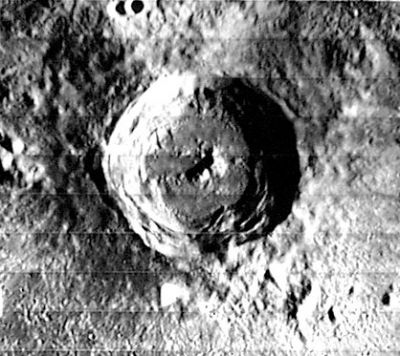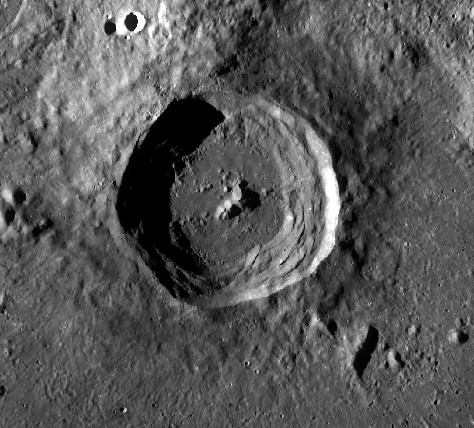Maunder
Contents
Maunder
|
Lat: 14.54°S, Long: 93.84°W, Diam: 53.8 km, Depth: 3.2 km, Rükl: (farside), [/Stratigraphy Eratosthenian] |
Table of Contents
[#Maunder Maunder]
[#Maunder-Images Images]
[#Maunder-Maps Maps]
[#Maunder-Description Description]
[#Maunder-Description-Wikipedia Wikipedia]
[#Maunder-Additional Information Additional Information]
[#Maunder-Nomenclature Nomenclature]
[#Maunder-LPOD Articles LPOD Articles]
[#Maunder-Bibliography Bibliography]
[#Maunder-E. Walter Maunder and Annie S. D. R. Maunder in the Sourcebook Project (William R. Corliss) E. Walter Maunder and Annie S. D. R. Maunder in the Sourcebook Project (William R. Corliss)]


left:Lunar Orbiter IV, right: LRO-WAC; LOLA measures the floor of Maunder as the deepest place within the Orientale Basin
Images
LPOD Photo Gallery Lunar Orbiter Images
Maps
([/LAC%20zone LAC zone] 90C3) USGS Digital Atlas PDF
Description
Wikipedia
Additional Information
- IAU page: Maunder
- Depth data from [/Kurt%20Fisher%20crater%20depths Kurt Fisher database]
- Pike, 1976: 3.2 km
- Westfall, 2000: 3.2 km
- [/Central%20peak%20composition Central peak composition]: GNTA1, GNTA2 & AG ([/Tompkins%20%26%20Pieters%2C%201999 Tompkins & Pieters, 1999])
- Exterior impact melt deposits most extensive to W, max of ~3 km beyond rim. Most extensive ejecta, rays and secondary craters to the SSE, and topographically lowest rim crest to SW ([/Hawke%20and%20Head%2C%201977 Hawke and Head, 1977]).
- TSI = 35, CPI = 15, FI = 25; MI =75 [/Smith%20and%20Sanchez%2C%201973 Smith and Sanchez, 1973]
Nomenclature
- According to the [/IAU%20Planetary%20Gazetteer IAU Planetary Gazetteer], the name honors a husband and wife, both British astronomers:
- Annie Scott Dill Russell Maunder (1868-1947), born in Ireland, collaborated with her husband, "Walter," especially in the investigation of historic sunspot records. She was the first woman elected to the Royal Astronomical Society.
- Edward Walter Maunder (1851-1928), born in London, served at the Royal Observatory, Greenwich, where, in collaboration with his second wife, Annie, he was the first to plot sunspot records in the form of the now-familiar "butterfly diagram." They also noted a possible correlation between sunspot activity and Earth's climate, including a period of low activity and cold weather much later referred to as the "Maunder Minimum."
- Although Maunder appears in the cumulative list of approved names in [/IAU%20Transactions%20XVB IAU Transactions XVB], it is not clear precisely when and where it was approved. Judging from its longitude, the name may have been introduced in the [/Rectified%20Lunar%20Atlas Rectified Lunar Atlas], but it is not included in the changes reported and approved in [/IAU%20Transactions%20XIIB IAU Transactions XIIB]. - JimMosher JimMosher
- List of features named for [/Nomenclature-Women women].
LPOD Articles
Bibliography
- Kinder, A. J. 2008. Edward Walter Maunder FRAS (1851-1928): his life and times. Journal of the British Astronomical Association, vol. 118, no. 1, pp. 21-42.
E. Walter Maunder and Annie S. D. R. Maunder in the Sourcebook Project (William R. Corliss)
- In Mysterious Universe, a handbook of astronomical anomalies (1979) :
- Page 8: Dark Markings in Solar Prominences (R.Daunt, Journal of the British Astronomical Association, 1906).
- Page 31: The Reaction of the Planets upon the Sun (Popular Astronomy, 1915). Note: in this article, E.W.Maunder's wife (Annie S.D.R. Maunder) is mentioned as co-researcher (photography of the sun).
- Pages 69 and 514: Note on a Solar Observation (E.E.Marwick, Journal of the British Astronomical Association, 1917).
- Page 379: The Canals of Mars (E. Walter Maunder, Knowledge, 1894).
- In Lightning, Auroras, Nocturnal Lights, and related luminous phenomena (1982) :
- GLA3-R11: A Strange Celestial Visitor (E. Walter Maunder, Observatory, 1916) (GLA3: Auroral Meteors: Moving Luminous Patches).
[/Alphabetical%20Index Named Featues] -- Prev: [/Mason Mason] -- Next: [/Maupertuis Maupertuis]
This page has been edited 1 times. The last modification was made by - tychocrater tychocrater on Jun 13, 2009 3:24 pm - afx3u3